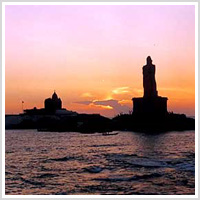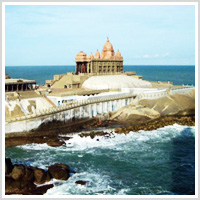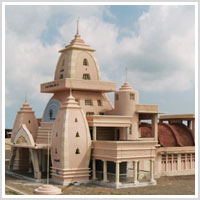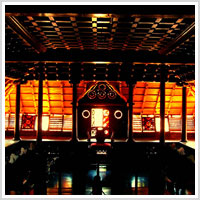
Chennai- Kanyakumari Tour Package
 |
Thiruvalluvar Statue |
|---|---|
The Thiruvalluvar Statue is a 133 feet (40.5 m) tall stone sculpture of the Tamil poet and saint Tiruvalluvar, author of the Thirukkural. It was opened in January 1, 2000 (Millenium) and is located atop a small island near the town of Kanyakumari, where two seas and an ocean meet; the Bay of Bengal, the Arabian Sea, and the Indian Ocean . The statue has a height of 95 feet (29 m) and stands upon a 38 foot (11.5 m) pedestal that represents the 38 chapters of "virtue" in the Thirukkural.
|
 |
Vivekananda Rock Memorial |
|---|---|
Vivekananda Rock Memorial is a sacred monument and popular tourist attraction in Kanyakumari, India. The memorial stands on one of two rocks located about 500 meters off mainland India's southernmost tip. It was built in 1970 by the Vivekananda Rock Memorial Committee in honour of the visit of the great spiritual teacher Swami Vivekananda to Shripada Parai during the month of December 1892 for deep meditation and enlightenment.
|
 |
Gandhi Mandapam |
|---|---|
Gandhi Mandapam in Kanyakumari, has been built on the spot where the urn containing the Mahatma's ashes was kept for public viewing before immersion. Later the ashes was immersed in the sea. Resembling central Indian Hindu temples in form, the memorial was designed in such a way that on Mahatma Gandhi's birthday, October 2, the first rays of the sun fall on the exact place where his ashes were kept.
|
 |
Padmanabhapuram Palace |
|---|---|
Padmanabhapuram Palace complex is located in at Padmanabhapuram Fort, close to the town of Thuckalay in Kanyakumari District, Tamilnadu. It is about 20 km from Nagercoil, and about 50 kilometers from Thiruvananthapuram, Kerala. The palace complex is inside an old granite fortress around four kilometers long. The palace is located at the foot of the Veli Hills, which form a part of the Western Ghats. The river Valli flows nearby. The palace is administered by the Government of Kerala archeology department.
|
 |
Thirparappu waterfalls |
|---|---|
Thirparappu falls is a natural beauty spot attracts many tourists. It is located at a distance of 5 km from kulasekaram. There is a lord shiva temple. The lord after destroying the yagam of dhaxan as virabhadra murthi has taken abode over here. This lord, who is very sweet for the sincere worshippers, is in a fierce form. This temple is one in the shivalaya ottam temples. There are many old inscriptions in this temple including the one of the pandiya king dated nineth century.
|



» Mumbai
» Rameswaram
» Kodaikanal
» Kanyakumari
» Munnar
» Palani
» Tiruchendur
» Madurai
» Kumarakom
» Athirapally
» Thekkady
» Ooty
» Bangalore
» Trichy
» Thanjavur
» Cochin
» Mysore


Home | Tours from Madurai | Special Packages | South Special | Tamil Nadu | Kumarakom | Munnar | Hyderabad | Goa | Book Tour | Contact
South India Packages
Copyright © 2010 Madurai Tours and Travels. All Rights Reserved
Website Design and Developed by Sri Hema Infotech
